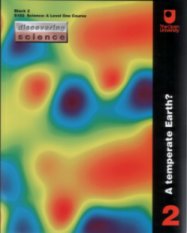S103 Discovering Science Diary
Block 2
[ Block 1 ] [ Block 3 ] [ Block 4 ]
3rd February
TMA02 is now finished, although I am not happy with some of it, so might change things a little. The cut-off date is not until 11th March, so plenty of time.
17th January 2003
Well, the rain gauge experiment is long gone and finished - as is the block by now! I have done most of TMA02, but there's not point in rushing as it doesn't need to be in until March 11th!!
15th December 2002
The rain gauge froze over during the week!! But, since then, there's been some rain falling almost constantly, so should get a better weekly mean this week (rather than the miserable 1.57mm of the first week!)
Plodding on through Block 2 with no great eagerness (oh how I HATE the darkness of this time of year), although it is quite interesting. Just on doing the earth's atmosphere.
I've learnt that my tutor's name is Dr Clare Smith (and her husband phoned to say that she was in Australia until 9th January!). And a great list of tutorial dates arrived through the post. There are 17 of them!!
8th December 2002
Thursday was the Grand Rain Gauge Opening!!

And, of course, it's hardly rained since!! In fact, it's been like some nuclear winter - dark and scary. But no rain. Well, a millimetre here; a millimetre there - but nothing that will show up as a plus to what's already in the gauge!
I've got as far as Chapter 3 in Block 2 and it's a bit of a plod. (I just don't find it all that interesting). I'm on pollen fossils as indicators of past climates. All is beautifully presented and explained well. But, every now and again, they bung in a sum. Why?
2nd December 2002
I looked around for empty coke bottles, to use in the rain collecting activity - but there are none. I went to the bin, but it wasn't there (Monday - outside the gate and waiting to be emptied). So, that will have to wait. As I have only the maths course to finish off - and as I've done most of the first S103 TMA, there is every reason why I might get on with this block and get a head start. Not today though.

Links
NERC Climate Change
NOAA Introduction to Palaeoclimatology
Hadley Centre for Climate Prediction and Research
United Nations Framework Convention on Climate Change
The Climate Impacts LINK Project
Wordwizz.com - From Quarks to Quasers - on the relative size of things
(Other links on main S103 page)
|
A temperate Earth? - Block 2 contents
The Earth's surface temperatures today and in the recent past
The Earth's surface temperature
Temperatures in the recent past
The Earth's surface temperatures in the distant past
Glaciers past and present
Evidence from ancient organisms
Ice ages past and future
What determines the Earth's GMST? Overview
A balance of energy gains and losses
What determines the Earth's GMST? A closer look
The rate of gain of energy from solar radiation
The rates of energy loss from the Earth's surface
Atmospheric radiation absorbed by the Earth's surface
So, what determines the GMST?
The Earth's atmosphere
What is a gas?
What is the Earth's atmosphere?
The composition of the atmosphere
Properties of gases in the Earth's atmosphere
The greenhouse gases
|
The water cycle
Precipitation
Evaporation and transpiration
What goes up goes around
Further aspects of the water cycle
A stable water cycle?
The carbon cycle
The most versatile of elements
The carbon cycle as a global chemical cycle
An overview of the carbon cycle
The biological carbon cycle
The geochemical carbon cycle
Return to the biological cycle
Cycles in balance?
Can we explain past variations in the GMST?
Global warming and cooling
Can we explain past climates?
The Earth's temperature in the future
The GMST and atmospheric CO2
How the GMST might change over the next 100 years
Possible consequences of a rise in the GMST
The Earth's climate beyond the year 2100
|
Back to S103
|

